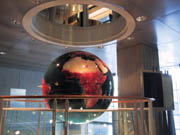
"The environment provides goods and services that sustain human development so we must ensure that development sustains the environment. Better natural resource management increases the income and nutrition of poor people."
One of the seven mission statements of the World Bank is to "ensure environmental sustainability," as read in the preceding paragraph. To set an example to other businesses, the bank teamed in a collaborative effort with a contractor, distributor and manufacturer to recycle acoustic ceiling materials. Because the bank considers the environment a key role in global development with trickle-down benefits for lesser-developed countries, this Washington-based special agency employs on-site contractors that specialize in environmental issues.
At its main offices in the business district of Washington, D.C., the bank has ongoing construction throughout its four locations. Part of this construction is replacing ceiling tiles. Like many other companies, the alternatives for disposal of old tiles were limited and usually the material ended up in landfills. But after hearing of a recycling program from Armstrong World Industries, the bank investigated what the requirements were.
"A colleague of mine gave me a copy of an Armstrong ceiling tile ad and we've been recycling carpet tiles to some lesser degree up until recently," says Vice President Joseph Matthews, AIC,CPC, of Centennial Contractors Enterprises. "We thought of how many tens of thousands of square tile we use in a year and that we should look into this (program)."

Submission
Centennial is a Vienna, Va.,-based construction management firm that specializes in the performance of indefinite-delivery, indefinite-quantity contracts for institutional, government and commercial clients. The company has been managing the bank's building maintenance and alteration services contract for the past 10 years and holds an office at the bank's H St. office.The Armstrong Ceiling Systems program enables commercial building owners to ship old ceilings from renovation projects to an Armstrong ceiling plant as an alternative to landfill disposal. The company uses the old tiles as raw materials in the manufacture of new acoustical ceilings. More than 13,000,000 square feet or 9,600,000 pounds of discarded ceiling tiles have been recycled since the program began.
A building owner or contractor must verify that the acoustical ceiling panels can be recycled to participate. Following verification, the participant must stack and arrange the old ceiling tiles on pallets and wrap them. (The old ceilings do not have to be Armstrong products to qualify.) Once there is a full trailer load or 30,000 square feet of ceilings tiles, the company will arrange for a truck to pick up the material and transfer it to its nearest manufacturing facility.
Considering this volume, World Bank/Centennial found that they didn't have the space to store the tiles for the extended period of time it took to accrue the required amount. So, rather than dismiss the idea of the program, the team looked to other resources for partnering.
What they found was that a local supplier/distributor could cost-effectively store the tiles throughout the year while the bank's offices in Washington would build up enough material to continue its annual shipments of material to be recycled.

Tag-team players
Capitol Building Supply worked in conjunction with Matthews and Armstrong Sales Representative Doug Oyler to develop a system to properly disperse of the material. How this assembly line works is that each of the bank's office buildings has its own room designated for storing the tiles and be loaded onto pallets. Then, the pallets will be picked up and stashed with Capitol, and then ultimately shipped to Armstrong. Centennial has to train its employees how to separate materials that will be considered reusable vs. what's waste.Capitol's inside sales representative Tony DiGuiseppe says that the company constantly makes deliveries to the World Bank so it made sense to load up the trailer with tile after new material was unloaded.
"Once we've collected 30,000 square feet of tile, we call Armstrong, which then arranges for a truck to pick them up and deliver them to its manufacturing plant," he says.
Initially, this program may be cost neutral to all parties involved: It may cost additional amounts in storage, transportation and other considerations. However, Matthews stresses the importance for such programs, regardless of cost and inconvenience.
"In the case of ceiling tiles specifically, you'll find this throughout most building materials. It's a highly competitive market and half-a-cent per square foot is the difference between having a sale and not having a sale. If you have competition, where one manufacturer is willing to forego the complete environmental movement and can sell their product for half-a-cent cheaper and the other one, who is environmentally grounded, has some incremental cost for doing this, then they lose the deal and that's a bitter pill to swallow. To Armstrong and Capital's credit, they realize it's not cost neutral; that they may end up spending some kind of money but it's a good investment because the world is moving toward this (programs like recycling) and to the extent of showing leadership."
Luis Descaire, director of the World Bank's General Services Department, confirms that the program aligns itself with the bank's own green program and mission statements for environmental endeavors.
"This is exactly the type of innovative program we want to implement as part of the bank's Greening Program," he says. "Especially because it fits in so well with our overall environmental initiatives. Our senior management is very committed to it. After all, we advise governments on environmental measures. If we can't practice what we preach, how can we expect our borrowers to do so?"
The bank's program is shaped by a philosophy from the likes of Matthews, Descaire and followers of other such organizations and groups. Associations, such as the United States Green Building Council, have long been looking for alternatives in construction practices to delay and stop the world's exhaustion of natural resources. Programs like LEED are still considered a voluntarily set of standards, so it's left to contractors and businesses to research, consider and then apply these practices.
As the teamwork of World Bank, Centennial, Capitol and Armstrong have shown, the benefits of these programs can encourage other businesses to partner with others that share likeminded interests in global activism.
Matthews concludes: "I think this is a wonderful opportunity to express to my colleagues and your readers that we all have a role in this and that we can ... make a better world for ourselves and maybe put back a few dollars in our pockets if we're lucky."



Report Abusive Comment